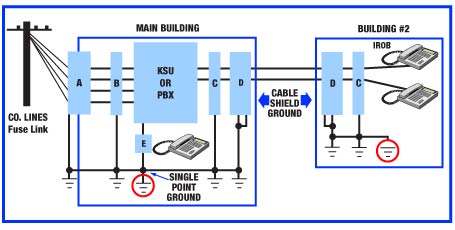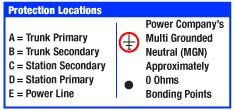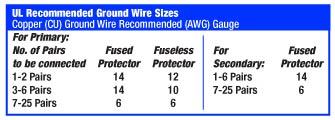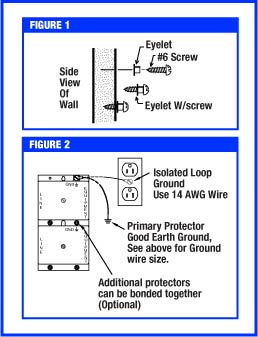How To Take Care of This Incredibly Important Variable
Needless to say, you must select the proper equipment to protect your sensitive phone/computer CPE. But that’s just part of the power-protection battle. Once the proper protector has been chosen, the next step is making sure everything is grounded correctly. The following items are critical to obtaining an optimum grounding system.
- Bonding
Bond or electrically connect together at a single point all of the grounds used for protectors on communications equipment. Typical grounds used for protectors are metal water pipes, ground rods, well casings, chemical rods, etc.(Consult local building codes for options as local building codes vary) The communications equipment is typically connected to the power company’s multi-grounded neutral (MGN) system and is the best source for a single-point ground. Connect the protector (primary and secondary) and cable shield grounds to the equipment grounds (i.e. Multi-grounded neutral) with a six AWG solid copper bonding wire (see chart).
- Physical Connections
Make sure to use the recommended ground wire size and UL Listed ground wire connections (again, see chart). For ground wire over 60 feet in length, the next largest wire gauge should be installed. Use a large radius at each bend in the ground wire. DON’T coil ground wire under any circumstances. Coiled wire can act as an inductor that dramatically increases the resistance of the path to ground, jeopardizing the effectiveness of overvoltage devices.
- Check Ground System Impedance
There are numerous brands of equipment and methods for checking the integrity of a grounding system. Pick one that tests both continuity and the impedance (total resistance) with respect to a true ground. An ideal ground should have an impedance under .250 ohms.
- Cable Shields
The metal cable shield should be bonded to the protector/ ground systems on both ends of the cable.
- Unused Cable Pairs
hey must be grounded on the unprotected side of the protector.
- Campus Building
Treat each building independently. Do all of these instructions in each building.
Is Grounding Important?
You bet your sweet voltage surge it is! The effectiveness of all overvoltage protectors relies on a path of least resistance for “dumping” transient voltages. The higher the resistance to ground, the higher the true activation level is for a protector (and the lower the activation level, the better).
Please don’t forget about grounding. Time spent on grounding basics may mean the difference between big downtime costs and an excellent return on your investment.



Bonding all protection grounds to the MGN is a sure method of preventing ground loop surges from damaging PBX/KSU cards and equipment. A number 6 AWG ground wire has .30 Ohms of resistance/thousand feet, providing a path of least resistance between MGN and points B, C, D, and cable shield.
Optional Grounding Instructions for SurgeGate and SecureLinx CAT5 and CAT6 Protectors
For Primary Protection Applications:
Connect the grounding strip to a good earth ground with a minimum 10 AWG wire. Use ring lug and machine screw provided. Route wire as direct and as short as possible.
Additional protectors could be bonded together as shown in figure 2 below. Must use a 6 AWG ground wire attached with a Screw Ground.
Notes:
- Never install telephone wire during a lightning storm
- Do not attach module to AC base unit in a Primary Application
- See additional notes below
For Isolated Loop Applications:
Connect the protector to a single point ground with a minimum 14 AWG wire as shown in figure 2 below. Additional protectors may also be bonded together as shown (dotted outline). Connect the protectors to a single point ground with a 6 AWG wire.
Notes:
- The protector shall be installed in accordance with the applicable requirements of the National Electric Code, ANSI/NEPA-70, Article 800, Section C
- Never install telephone wiring during a lightning storm
- Voltage breakdown Rating @ 100V/sec. : 16V = 12-2
Optional Mounting Instructions for SurgeGate and SecureLinx CAT5 and CAT6 Protectors
Mount protector to a solid surface, like plywood. Drill a 3/32 hole for the #6 x 3/4 screw and eyelets provided. See figure 1 below. Attach screw and eyelet to wall and slide protector over screw and tighten. Add second screw to bottom of protector.
